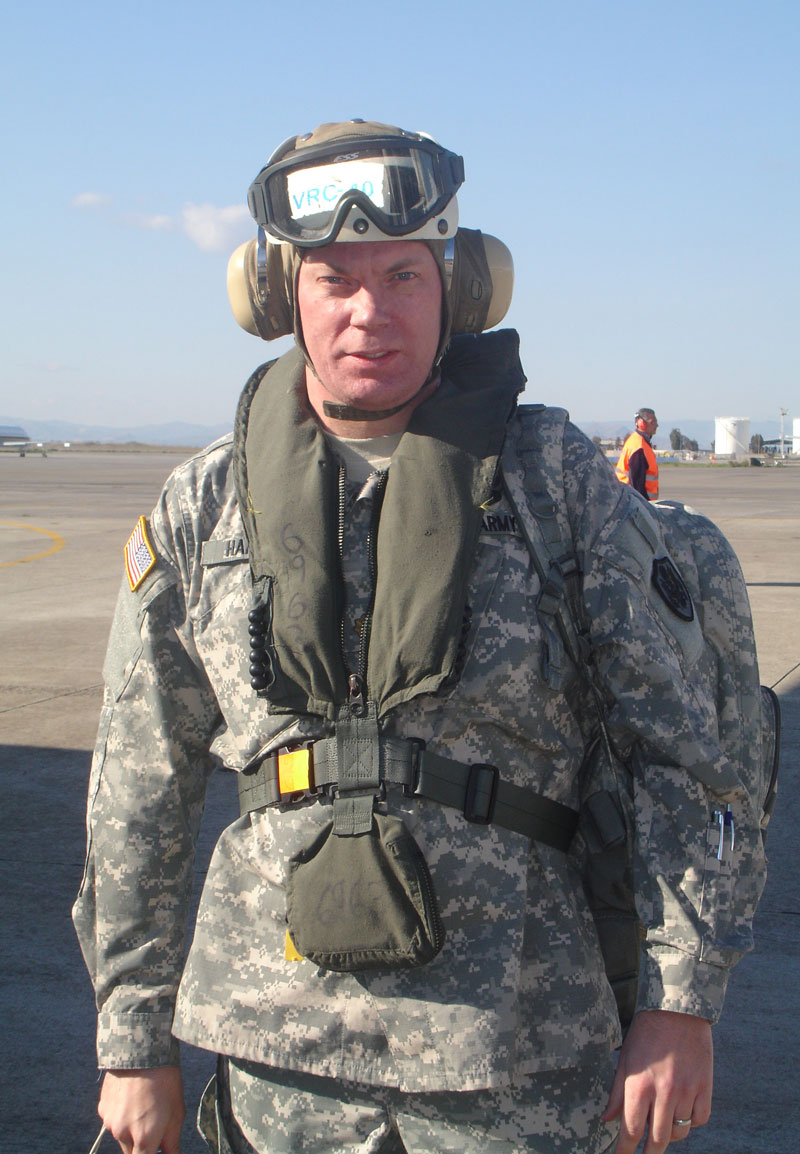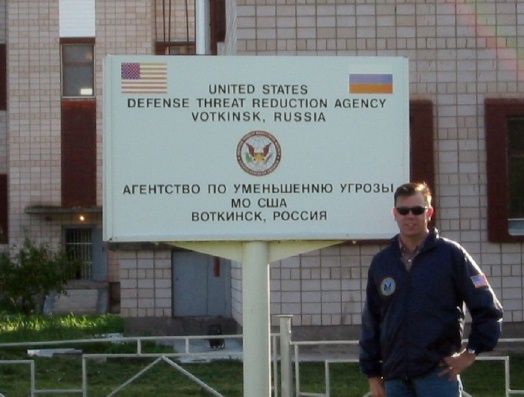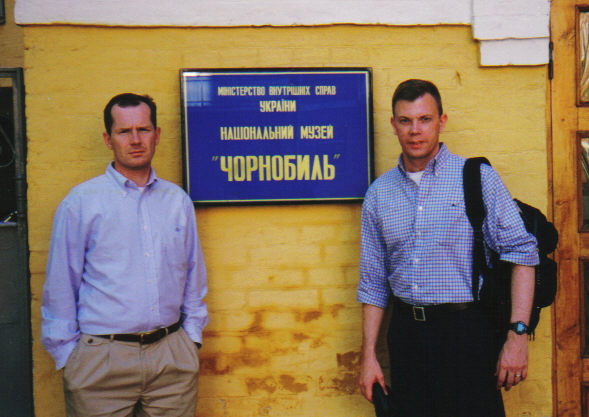
CONSULTING ALLIES: Brig. Gen. Garrick Harmon, left, commander of the Security Assistance Command at Redstone Arsenal, spoke with senior military members of the Polish army during a June 1 meeting. (Photo by Tim Hanson, USASAC)
Brig. Gen. Garrick Harmon, commander of USASAC, shares his insights on enterprise collaboration, forged in fire while he was the senior U.S. military official in Russia.
by Ellen Summey
If you’re the DOD senior military representative to the Russian Federation, it’s your job to keep the lines of communication open—even when things are really, really difficult. The stakes are too high and any miscommunication could lead to conflict.
“One of the worst things that could have happened to us would have been an incident over the Black Sea, for example, where two aircraft accidentally clip wings, and something unfortunate happens,” said Brig. Gen. Garrick Harmon. “If the first part of our conversation was going to be, ‘Hey, what’s the phone number to that one guy that we used to talk to?’ That’s the position we didn’t want to be in.” Now the commanding general of U.S. Army Security Assistance Command (USASAC), Harmon was previously the U.S. senior defense official and defense attaché to the Russian Federation. “When you’re trying to prevent a miscalculation from escalating into a full-blown crisis, established lines of communication are vital,” he said.
Harmon has made a career of building relationships through his work as a foreign area officer (FAO), and he shared his insights on enterprise collaboration during an interview with Army AL&T in June.

PREPARE TO BOARD: Harmon at Naval Air Station Sigonella, Sicily, before embarking to the USS Enterprise in the Mediterranean Sea with the president, minister of defense and chief of defense of Estonia in December 2007. (Photo courtesy of Brig. Gen. Garrick Harmon)
FIT FOR PURPOSE
USASAC is known as the “Army’s face to the world,” because of its established, enduring relationships with nations worldwide and because it leads Army Materiel Command’s (AMC) security assistance enterprise, developing and managing security assistance programs and foreign military sales with allies and partners. When Harmon assumed command of USASAC in May, he spoke about the critical nature of this type of work. “At a time of increasing levels of military competition around the globe, and as we seek to expand the global land power network as part of our approach to a multidomain Army in competition, the important role of security assistance through foreign military sales will continue to grow,” Harmon said. And with $209 billion worth of foreign military sales in more than 135 countries, the command’s scope is huge.
Harmon’s extensive experience as a foreign area officer has given him a unique perspective on this type of collaborative, relationship-focused work. “I’m not the traditional sustainment or acquisition officer, but I have sat on various sides of this important enterprise over my career as an FAO,” he said in the interview. “The end state is ‘win in competition, be decisive and prevail in conflict and crisis,’ and we’re only going to do that with allies and partners.”
Gen. Edward M. Daly, commanding general of Army Materiel Command, presided over the ceremony at Redstone Arsenal, Alabama, and spoke about Harmon’s unique qualifications for the job. “He has spent the last 22 years studying foreign nations and languages, and serving in international posts from Germany to Spain, to Georgia to Afghanistan, along with several Pentagon assignments,” he said.
That’s putting it mildly.

HOT AUGUST NIGHT: Fireworks above Red Square in Moscow in August 2019. Part of Harmon’s job as U.S. senior defense official and defense attaché to the Russian Federation was to ensure fireworks didn’t turn into a firefight. (Photo by Brig. Gen. Garrick Harmon)
COLLABORATION COUNTS
Harmon was selected as the U.S. senior defense official and defense attaché to the Russian Federation in 2018, after serving in a number of Defense Intelligence Agency assignments in Estonia, Georgia and Russia. Being a high-ranking American diplomat and the senior DOD representative in Russia at that time—amid widespread protests over domestic conditions, tit-for-tat expulsions of diplomats over a suspected nerve agent attack in the U.K., the COVID-19 pandemic and the ongoing controversy about Russia’s alleged tampering with the 2016 U.S. presidential election, among a litany of other difficulties—is probably not anyone’s idea of a walk in the park. “Simply put, it was an extremely challenging period, but I had the honor of working with an exceptional interagency team to navigate a complex landscape,” Harmon said.

TOUR OF DUTY: Harmon outside the Votkinsk Portal Monitoring Facility in Votkinsk, Russia, in October 2005. (Photo courtesy of Brig. Gen. Garrick Harmon)
Not only was he tasked with navigating the fraught relationship between the U.S. and Russia, he also faced administrative and staffing hurdles in his own office. “I was the first DOD person back into Embassy Moscow following all the Russian government-directed staffing reductions in September 2017, followed by the diplomatic expulsions in April of 2018. The DOD presence in Moscow had been reduced by almost 80 to 85 percent over that period of time,” he recalled. “Instead of the full office that I was accustomed to in my first tour, I arrived back to an office that had three people that had to manage that very difficult relationship for a period of about eight months with limited support,” he said.
But even in that very tense environment, Harmon said he knew his mission was to focus on dialogue and engagement. As any therapist would confirm, sometimes the most difficult relationships require the most intentional conversations. “Even at the height of the Cold War, the U.S. and the Soviet Union always had to find a way to have lines of communication with each other. We had to find a way to ensure that we didn’t inadvertently create a situation where we introduced risk of miscalculation and escalation and increase the likelihood of a crisis or a conflict because of lack of dialogue and lack of understanding,” he said. “In that very difficult environment, at my level, we valued the ability to talk, military-to-military, for the purposes of transparency and risk reduction, about our activities and what we were doing, with the goal of also trying to understand Russia’s strategic intentions. Of course, bilateral dialogues require equally committed and transparent interlocutors.”
Thus, the earlier hypothetical Black Sea scenario. As the U.S. senior defense official in Russia, that late-night phone call would have been Harmon’s to make.

REMEMBERING CHERNOBYL: Harmon, right, at the Chernobyl Museum in Kyiv, Ukraine, in April 2000, along with Col. John Burbank, since retired. (Photo courtesy of Brig. Gen. Garrick Harmon)
TRAIT AGREEMENT
Thankfully, the U.S. has more congenial relationships with the bulk of its other international partners. Harmon cited his time in Estonia as one example, and said there are important lessons to be learned in those experiences, as well. “In a place like Estonia, what you learn is that we have a lot of great allies and partners out there. The ability to get to work with them side by side, when it comes to training and exercises, when it comes to capabilities acquisition, working with a partner and really understanding them, understanding their military and how we can work together bilaterally and multilaterally, it was a great case study in how to do things well,” he recalled. “Through our close relationship with the Estonians and by extension our close relationship with other Baltic nations, you really learn about engagement, you really learn about the importance of allies and partners. You also really understand the threat from a partner perspective, too, and how [our work] with allies and partners in military competition becomes absolutely critical to face that threat.”
Managing international collaboration and engagement on such a large scale requires certain skills and experiences, Harmon said. “It starts with some of the key skillsets that all [foreign area officers] need to have, which is really the critical thinking, the analysis, the clear and effective communication. Being able to provide clear, cogent recommendations, well informed by your nuanced understanding of a host nation, the broader region and the threat, to senior leaders is important.” Those officers, perhaps better than anyone else in the security assistance enterprise, understand their host nations and the threats they face, so it’s important to harness that expertise “so that we can help deliver what a nation requires to support its national defense as well as regional or global operations” through security assistance or foreign military sales, he said.
“It starts from that understanding that can only come through routine engagement. It starts with that clear, concise communication, and the understanding of shared interests and opportunities.”

FLYING HIGH: Harmon with Army astronaut Col. Andrew Morgan at Baikonur Cosmodrome, Kazakhstan, prior to Morgan’s launch to the International Space Station in July 2019. (Photo courtesy of Brig. Gen. Garrick Harmon)
LEADERSHIP PRIORITIES
Harmon is, by virtue of his international experience, a natural advocate for the work of USASAC, and he’s a champion for his workforce as well. When discussing his goals as commanding general, he spoke highly of his predecessor and the strategic goals he established. “Even before I got here, the team had already done an enormous amount of work, and the previous [commanding general, Brig. Gen. Doug Lowrey] too, developing a security assistance enterprise strategy for 2021,” he said.
The command identified three lines of effort, roughly centered on people, modernization and program execution. Harmon said he will continue working toward those priorities and look for opportunities to make foreign military sales more agile and responsive to partner needs in support of military competition.
“My focus will be on further building out those lines of effort,” he said. “With any organization, whether it’s USASAC, the Army, DOD or beyond, it’s really the people that are the key of what we do, and we need to invest in and grow the security assistance experts of the future. For this organization, it’s the people that execute the process, it’s the people that lead the engagement, it is the people that deliver the strategic effect that we’re seeking with allies and partners. … I tell people, even if you spend your day in a cubicle, staring at a computer screen, if you ever doubt the impact that you have at the strategic level, disabuse yourself of that now. Everything that you do here on a day-to-day basis, managing a difficult and critical process, has a strategic impact with an ally or partner that is almost immeasurable.”

TAKE COMMAND: Gen. Ed Daly passes the USASAC flag to Harmon, officially transferring command of USASAC to Harmon from Brig. Gen. Doug Lowrey (far right), at a May 17 ceremony at Redstone Arsenal. Harmon says he will continue Lowrey’s three lines of effort: people, modernization and program execution. (Photo by Kimberley Capehart, USASAC)
The organization’s other primary goals—modernization and program execution—center on the ins and outs of security assistance. USASAC will prioritize the measured, coordinated execution of its comprehensive security assistance program, Harmon said, while also focusing on where it can improve. “Are we doing everything possible to build partner capacity, are we supporting what the combatant commands want to do, and how are we helping to reinforce the trust and further build those relationships around the world through foreign military sales?” he said.
“We’ll want to look at how we want to modernize the AMC security assistance enterprise for tomorrow,” Harmon continued. “Through innovation, new ideas and understanding what we can do to better position the [enterprise] within the existing policies and processes. Do we have the right authorities, do we have the right policies and processes to be as agile as necessary so that we can effectively compete?”
And with the Army’s sights set on modernization, Harmon said USASAC will help ensure that the U.S. remains interoperable with its allies and partners. “It will be important to understand where Army modernization is going and how it may drive future FMS opportunities, while also preserving the ability to be interoperable with allied and partner legacy systems, because that level of interoperability remains absolutely critical in a future conflict,” he said.

WARMING UP: Harmon, right, meets with Finnish reserve officers at an international military competition near Johvi, Estonia in January 2008. (Photo courtesy of Brig. Gen. Garrick Harmon)
CONCLUSION
Collaboration is more than a nice-to-have for the United States and its international partners. It’s the foundation on which the nation will build its future. “Our senior leaders have said it many times—we are not going to fight the next war by ourselves, we’re going to do it with allies and partners. A command like this allows us to bring together the understanding of the threat, the understanding of priorities and opportunities, and the understanding of the importance of foreign military sales in support of ally and partner requirements. The security assistance enterprise will ensure that we can compete effectively, and FMS gives us that network that we need so that, should there be another conflict, should there be another crisis, we will be decisive in our victory, as a result of years of investment in our relationships.
“It’s that work that we do over time that guarantees the success of the future.”
For more information, go to www.army.mil/usasac/.
ELLEN SUMMEY provides contract support to the U. S. Army Acquisition Support Center at Fort Belvoir, Virginia, as a writer and editor for SAIC. She holds an M.A. in human relations from the University of Oklahoma and a B.A. in mass communication from Louisiana State University. She is certified as a Project Management Professional, Change Management Professional and User Experience Manager, and has more than 15 years of communication experience in both the government and commercial sectors.







